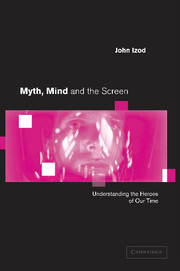Book contents
- Frontmatter
- Contents
- Acknowledgments
- Introduction
- 1 Jungian theory, textual analysis and audience play
- 2 Archetypal images: signification and the psyche
- 3 Archetypal images: symbols and the cultural unconscious
- 4 The Piano, the animus and colonial experience
- 5 The pop star as icon
- 6 The quest of a female hero: The Silence of the Lambs
- 7 Television sport and the sacrificial hero
- 8 The polycentred self: The Passion of Darkly Noon
- 9 Haunted: searching for the whole self
- 10 Transforming the final ghost: the god within
- Conclusion
- Filmography
- Glossary of Jungian and related terms
- References
- Index
5 - The pop star as icon
Published online by Cambridge University Press: 22 September 2009
- Frontmatter
- Contents
- Acknowledgments
- Introduction
- 1 Jungian theory, textual analysis and audience play
- 2 Archetypal images: signification and the psyche
- 3 Archetypal images: symbols and the cultural unconscious
- 4 The Piano, the animus and colonial experience
- 5 The pop star as icon
- 6 The quest of a female hero: The Silence of the Lambs
- 7 Television sport and the sacrificial hero
- 8 The polycentred self: The Passion of Darkly Noon
- 9 Haunted: searching for the whole self
- 10 Transforming the final ghost: the god within
- Conclusion
- Filmography
- Glossary of Jungian and related terms
- References
- Index
Summary
It is not hard to see that the techniques of Jungian textual analysis can be used to interpret the cultural meaning of those music stars who stir the popular imagination. Rock and pop stars have comparable standing as popular icons to their equivalents in film and television. In so far as the production of star personalities is concerned, this occurs because the publicity machines and marketing apparatus behind all the leisure industries construct and promote their stars to audiences through broadly similar mechanisms. What is more, the industry prefers crossovers, with stars working in more than one medium, as a means of broadening the market. So pop stars produce not only CDs, audio tapes and vinyl, but also video tapes for TV broadcast. Web sites are set up in their names; corporate concerns market tie-ins with their images, such as T-shirts advertising concert performances, or personal endorsements of products (Madonna advertising Max Factor make-up in glossy magazines in 1999). And this is to say nothing of their appearances in movies.
Star personalities in every medium possess a form of capital, namely their own image. The right to make use of that image is the saleable commodity that, guided by agents, managers and publicists, they control and exploit. In semiotic terms, what they sell is a sign. As their cross-media activities imply, stars function as signs, no matter in which medium they flourish, that have been more or less deliberately constructed to carry certain meanings.
- Type
- Chapter
- Information
- Myth, Mind and the ScreenUnderstanding the Heroes of our Time, pp. 79 - 104Publisher: Cambridge University PressPrint publication year: 2001



